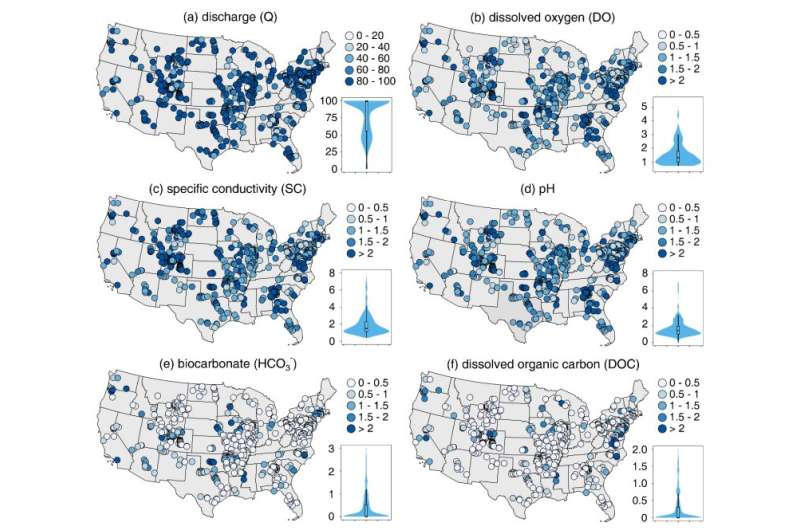This article has been reviewed according to Science X's editorial process and policies. Editors have highlighted the following attributes while ensuring the content's credibility:
fact-checked
peer-reviewed publication
trusted source
proofread
Study shows temperature is stronger than light and flow as driver of oxygen in US rivers

The amount of dissolved oxygen in a river is a matter of life or death for the plants and animals living within it, but this oxygen concentration varies drastically from one river to another, depending on their unique temperature, light and flow. To better understand which factor has the greatest impact on the concentration of dissolved oxygen, researchers at Penn State used a deep learning model to analyze data from hundreds of rivers across the United States.
Oxygen concentration is an important measure of water quality because fish and other aquatic organisms require dissolved oxygen to breathe, according to Wei Zhi, assistant research professor of civil and environmental engineering and first author of the study, recently published in Nature Water.
"Studies have shown that three major factors—flow, temperature and sunlight—influence the amount of dissolved oxygen found in a river or stream," Zhi said. "We wanted to know, at the U.S. continental scale, which of these competing drivers was dominant."
According to corresponding author Li Li, Barry and Shirley Isett Professor of Civil and Environmental Engineering at Penn State, the common perception is that all three factors matter: how quickly a stream flows impacts how fast oxygen in the air can dissolve in the water; temperature affects how much oxygen the water can pull from the air; and the level of sunlight shining into the water affects how much oxygen the plants in the water can make on their own.
"It is challenging, however, to figure out which of these factors is the most important at a continental scale because of different amounts of monitoring data in different rivers at different times," Zhi said. "There has been little consistency in the way dissolved oxygen concentrations have been measured in different rivers. For example, some rivers were measured only in the 1980s in the summers, and some rivers were measured only in the 2000s in the spring."
Using 40 years of data from 580 rivers across the contiguous U.S.—each with unique temperature, flow and sunlight conditions—the researchers trained a long short-term memory deep learning model to figure out the relationship between the weather conditions and dissolved oxygen.
"Traditionally, it has been very difficult to predict the dissolved oxygen levels on such a large scale, simultaneously with one model," Li said. "But with a deep learning and big data approach, we can do that. Deep learning models enable large-scale systematic analysis of patterns and drivers."
The model revealed that, at a continental scale, temperature outweighed light and stream flow in controlling the dissolved oxygen dynamic. Light was the second-important factor on dissolved oxygen levels, while stream flow had minimal influence, according to the findings.
"Temperature is the predominant driver of daily dissolved oxygen dynamics in U.S. rivers," Zhi said. "Fairly accurate predictions of oxygen concentration can be made by temperature alone. Dissolved oxygen is declining in warming rivers, which has important implications for water security and ecosystem health in the future warming climate."
More information: Wei Zhi et al, Temperature outweighs light and flow as the predominant driver of dissolved oxygen in US rivers, Nature Water (2023). DOI: 10.1038/s44221-023-00038-z
Journal information: Nature Water
Provided by Pennsylvania State University





















